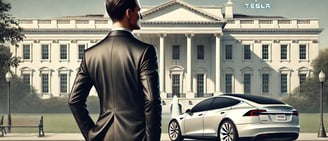Why Elon Musk Chose Team Trump: The Power Struggle Behind America’s EV Revolution
Wondering why Elon Musk joined forces with Team Trump? Dive into the untold story of power plays, White House snubs, and the electric vehicle revolution. This isn’t just about cars—it’s about politics, influence, and the fight to shape the future of clean energy in America.


Do you wonder why Elon Musk chose "Team Trump?" It all started back at the beginning of the Biden administration, in what might feel like a bit of an electric plot twist.
When Biden first took office, Musk and Tesla actually seemed poised for a good relationship with the White House. Biden's clean energy agenda looked like a tailor-made fit for Tesla’s mission to accelerate the transition to sustainable energy. In fact, during Biden’s first few months, the administration was enthusiastic about Musk’s trailblazing electric vehicle (EV) company, Tesla. However, after an initial meeting, Musk found himself increasingly shut out of key conversations around EV policies, charging standards, and the future of zero-emission vehicles in the United States.
The Big EV Meeting (Without Tesla)
In August 2021, the Biden administration hosted a White House summit to discuss the future of electric vehicles, but Tesla—the company responsible for 74% of the country’s EV sales—wasn’t invited. Instead, the summit spotlighted the CEOs of Ford, GM, and Stellantis, three legacy automakers with established Washington connections and powerful lobbying arms. It was a conspicuous absence that Musk, never one to hold back, openly called "odd."
But there was more at play than just a missed invitation. Legacy automakers have long been key political contributors and were particularly close to Biden’s administration, partly because of their unionized workforce. For years, the United Auto Workers (UAW) and other unions had championed GM, Ford, and other “traditional” automakers, supporting them with political donations and calling for policies that favored union-friendly manufacturing. Tesla, on the other hand, is famously non-union—a sticking point that may have influenced the administration’s cold shoulder.
The Charge Against Charging Standards
The story didn’t stop with one snub. As Biden’s administration rolled out policies for EV adoption, federal incentives, and infrastructure standards, Tesla and Musk found themselves sidelined again and again. Legacy automakers wielded their power to influence new standards around EV charging, pushing for requirements that favored their own emerging networks over Tesla’s robust Supercharger network. Tesla’s charging infrastructure was often recognized as one of the best in the world, but these policies allowed GM and Ford to keep the upper hand by setting standards that kept Tesla out of the picture.
At the same time, federal EV incentives continued to support legacy automakers, even when they were producing less efficient and less popular models. Despite their lower ranges and less desirable designs, Ford, GM, and Stellantis EVs were propped up by tax credits and incentives, while Tesla, with its market-leading vehicles, was left on the outside looking in.
Ford’s Investment in Rivian
To add another twist, Ford—the same company at the White House summit—invested in Rivian, another electric vehicle start-up with big ambitions. By financially backing Rivian, Ford could tap into the start-up’s innovative approach to EVs while also safeguarding its legacy power. In this way, Ford could hedge its bets, benefiting from Rivian’s innovation without truly ceding ground to Tesla.
Musk’s Pivot to Trump’s Camp
Elon Musk didn’t sit quietly. Faced with what he saw as a stacked deck, Musk began to look elsewhere for support. Here’s where the story takes a political twist: Musk pivoted his focus toward Trump’s administration. Trump had taken a different approach to EV policies—one with fewer subsidies and less federal control. This meant less competition fueled by government handouts for Tesla to worry about.
Aligning with Trump provided Musk a platform to advocate for more market-driven EV standards, potentially leveling the playing field. Musk could now champion policies that promoted innovation over federal support for legacy players. With Trump’s support, Musk pushed for the removal of federal EV incentives altogether, believing that a competitive, subsidy-free market would force other manufacturers to compete based on quality and performance—areas where Tesla excelled.
The Road Ahead: Legacy Automakers and Changing Behaviors
Elon Musk’s decision to align with Trump wasn’t just about politics; it was about survival and competition in a market heavily influenced by established players. Legacy automakers, despite entering the EV market, have been slow to change their behavior. They’ve used their political clout to shape policies in their favor, often focusing on protecting their economic interests over advancing the technology itself.
For Musk, choosing Team Trump was a way to level the playing field and shift the narrative. The next chapter of the EV race remains unwritten, but one thing is clear: as legacy automakers continue to leverage power to shape the industry, Tesla and Musk will find ways to fight back.



